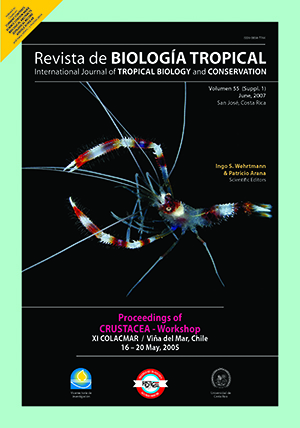Abstract
Commercial bottom trawling is a successful and commonly used method to catch marine shrimps. However, the shrimp fishing gears are poorly selective, and in addition to the target species they catch and retain large quantities of non-target species (bycatch). This study presents data concerning species composition and depth distribution of the crustacean fauna (stomatopods and decapods) associated with Heterocarpus vicarius catches from Pacific Costa Rica. A total of 74 samples (three to five 20 min-tows each month) were taken between January 2004 and December 2005 with commercial shrimp trawlers at depths varying between 192 and 350 m. In all depth ranges analyzed, total catch of crustaceans was significantly higher than that of fishes. A total of 28 decapods and two stomatopod species were identified. In comparison to other bycatch composition of comparable fisheries in Latin America, the crustacean fauna of the H. vicarius fishery in Costa Rica is highly diverse. Most common species were Solenocera agassizii (Solenoceridae), Squilla biformis (Squillidae), Plesionika trispinus (Pandalidae), and Pleuroncodes sp. (Galatheidae), reaching total catch percentages of 57.2 %, 81.5 %, 91.8 %, and 99.6 % of individual catches, respectively. The results presented herein may contribute to the development of responsible management strategies for the deepwater fisheries in Costa Rica and Central America.##plugins.facebook.comentarios##

This work is licensed under a Creative Commons Attribution 4.0 International License.
Copyright (c) 2007 Revista de Biología Tropical
Downloads
Download data is not yet available.


